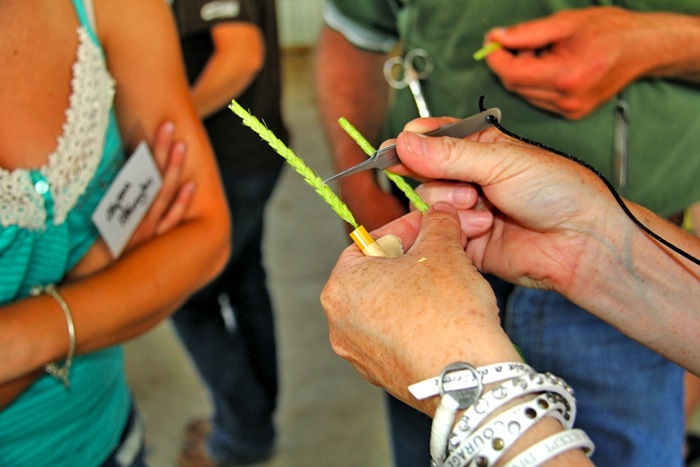The more I learn about plant breeding, the more I feel I missed my true calling in life.
And a recent attempt at crossing two barley plants at the Lacombe Field Day only fuelled my secret ambition.
I worked with Laura Hoge, a germplasm technician at Alberta Agriculture and Rural Development, in a machine shed with plants pulled from the field. Breeders normally work with live female plants and pulled male plants, sitting on a stool with sharp tweezers and tiny scissors for hours, snipping and tweezing and pollinating the females with the males.
Read Also

Hail research hopes to benefit potato growers
Alberta research scientist measures hail storm and heat dome affects on potato crops
Tweezers in one hand and scissors in the other, I set to work on my female plant, stripping away the flag leaf carefully so as not to break the spike from the stem. Once the spike was free of the boot, I tweezed off the infertile lateral florets from the female plant, leaving two seeds on either side of the spike.
Next, the awns were trimmed off each floret just above the little bump (my term), creating a small opening that would allow me to tweeze three delicate anthers from each floret on both sides of the spike. The anthers should be small and green, Hoge said, and all must be removed to prevent self-fertilization, which renders the whole spike useless.
The entire process takes around 10 minutes per plant, and an experienced breeder can do 40 in a day.
- More from the Alberta Farmer Express: Big changes coming to plant breeding
In a normal crossing, we would put a bag called a diaper (their term) on the plant and wait three days. We didn’t have that kind of time, so I simply removed the anthers from each floret on the male plant in much the same way I did the female plant. But this time, I dusted the male anthers along the head of the female plant to pollinate the emasculated female.
After each floret is pollinated, Hoge explained, a straw plugged with a bit of wax is taped to the side of the female spike. The male spike is placed in the straw, and given water so it won’t dry out as it releases pollen over the next several days.
At that point, the diaper goes back on the female plant, and within seven to 10 days, new seeds start to develop. Once the seeds are fully mature, the emasculated plants are harvested by hand and then sorted one by one in the lab.
With just high school biology, I may not have the makings of a true plant breeder. But after my first foray into honest-to-goodness hands-on plant crossing, my dream is alive and well. I think I’ll name my first variety AC Express.















